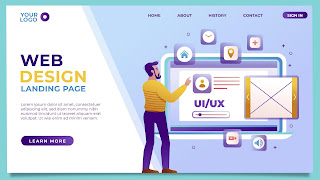Dynamic website and responsive web design
Dynamic website and responsive web design are two different concepts in web development.
A dynamic website is a website that is created with dynamic web pages, which means that the content is generated on the fly, typically using a server-side programming language such as PHP, Ruby, or Python. The content is usually stored in a database, and when a user requests a page, the server retrieves the data from the database and generates an HTML page that is sent to the user's browser. Dynamic websites are more complex than static websites but offer more interactivity and functionality.
Responsive web design, on the other hand, is a design approach that aims to create websites that are optimized for different screen sizes and devices. A responsive website will adjust its layout and content based on the device it is being viewed on, whether it is a desktop computer, tablet, or smartphone. This is achieved through the use of CSS media queries, which allow developers to define different styles for different screen sizes.
Responsive web design is becoming increasingly important as more and more users access the web on mobile devices. By creating a responsive website, developers can ensure that their website looks and works well on all devices, which can improve the user experience and lead to increased engagement and conversions.
In summary, a dynamic website is one that is generated on the fly using server-side scripting, while responsive web design is a design approach that optimizes websites for different screen sizes and devices. Both are important concepts in web development and can be used together to create modern, functional, and user-friendly websites.
Aesthetically pleasing web design and user friendly websites
Aesthetically pleasing web design and user-friendly websites are two key elements of successful web design. While they are different concepts, they are closely related and both play an important role in creating a website that is effective and engaging for users.
Aesthetically pleasing web design refers to the visual aspects of a website, including the use of color, typography, layout, images, and graphics. An aesthetically pleasing website is visually appealing, well-organized, and consistent in its design. It helps to create a positive first impression for visitors, and can also help to reinforce branding and messaging.
User-friendly websites, on the other hand, focus on the usability and functionality of a website. A user-friendly website is easy to navigate, intuitive, and designed with the needs of the user in mind. It should be easy to find information, complete tasks, and interact with the website. A user-friendly website can help to improve engagement, reduce bounce rates, and increase conversions.
In order to create a successful website, it is important to balance both aesthetic appeal and user-friendliness. A visually stunning website that is difficult to navigate or use may turn visitors away, while a highly functional website with poor design may not attract or engage users.
To achieve an aesthetically pleasing and user-friendly website, it is important to understand the target audience, their needs and preferences, and to design a website that meets those needs. Design elements such as color, typography, and layout should be carefully chosen and applied to create a cohesive and visually pleasing website. Navigation should be intuitive and easy to use, and content should be organized and easy to find. By balancing these elements, a website can create a positive user experience that will encourage visitors to engage with the website and return in the future.
UX/UI design for website
UX (user experience) and UI (user interface) design are two critical aspects of designing a website that is both effective and engaging for users.
UX design focuses on the overall experience that users have when interacting with a website. This includes the flow of the website, the ease of navigation, and the overall usability of the site. UX designers will typically start with research to understand the needs and preferences of the target audience, and will then use this information to create wireframes and prototypes that test the flow and usability of the website. The goal of UX design is to create a website that is easy to use and intuitive for users.
UI design, on the other hand, focuses on the visual aspects of a website, including the layout, typography, color, and other design elements. UI designers work closely with UX designers to ensure that the visual design supports the overall user experience. They create visual designs that are consistent with the brand and messaging of the website, and that are visually appealing and easy to use.
Together, UX and UI design work to create a website that is not only visually appealing, but also intuitive and easy to use for the target audience. They help to create a positive user experience that encourages visitors to engage with the website and return in the future. Some key principles of UX/UI design for websites include:
1. User research: Understanding the needs, preferences, and behaviors of the target audience is critical to creating a website that meets their needs.
2. Usability testing: Testing the website with users can help identify areas for improvement and ensure that the website is easy to use and intuitive.
3. Visual design: Creating a visual design that is consistent with the brand and messaging of the website can help to reinforce the overall user experience.
4. Interaction design: Designing interactions that are intuitive and easy to use can help to create a positive user experience.
By focusing on UX and UI design, web designers can create websites that are not only visually appealing, but also easy to use and engaging for users. This can help to improve engagement, reduce bounce rates, and increase conversions.





No comments:
Post a Comment